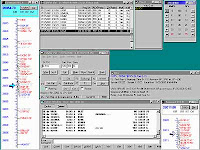But for the next few postings, I'd like to talk about a different kind of toolbox: a software toolbox.
Just like the one in the picture, my ham radio software toolbox has several compartments and different types of tools, depending on the job that I want to do. I'll describe a few of the compartments that I have and the tools that I use. Before I start, I will say that these are tools that I've found work for me. There may be tools that work better for you (and there are are probably some that would work better for me too, but you have to start somewhere.) Since I'm a Windows XP user, everything I'll discuss runs on that platform. (Sorry to the Mac and Linux guys.) I have no financial interest in any of the software that I'll talk about, other than in the case of the commercial products, I'd sure like to see those companies stay around for a while. So let's go see what's in the toolbox.
The Logging Tools
For the most part, I use two different types of tools, depending on why I'm logging contacts. I guess I consider myself a DXer first, so I use a DX logging program that I've found works well for me, which is DX4WIN. (Hmm, seems that their home page is a bit out of date. Fortunately, the software isn't.) DX4WIN allows me to track progress towards awards like DXCC, IOTA, and WAS (and many more), and does a nice job handling QSLing chores. It has reasonable integration with Logbook of The World, and is able to import and export information in a wide variety of formats. That's important, because I import data into DX4WIN from my contest logging program (more about that in a bit), and occasionally I'll even need to export from DX4WIN to my contest logger. I consider this my primary logging program, and everything that I log eventually winds up in DX4WIN.
The other logging tool type I use is when I'm participating in a contest. For that, I use the amazing N1MM Logger. N1MM
 (the logger, not Tom, N1MM) is rapidly becoming the choice of a lot of very serious contest stations because of it's flexibility, power, and support, but I find it great to use for my casual contesting as well. It can integrate with multiple radios, has built-in CW and voice keyers, can work with network connected multi-op stations, and, well, just about does everything about contesting really well. As if that wasn't enough, it's freeware and open source. (I actually did a couple of very small pieces to support Icom radios back when it wasn't as well known.) As I mentioned before, the main repository for all my QSL data is DX4WIN, so when I finish a contest, I export the data in a number of formats that I need, including Cabrillo for the contest submission, and ADIF for uploading to Logbook of The World and importing into DX4WIN. Just a couple of mouse clicks is all it takes.
(the logger, not Tom, N1MM) is rapidly becoming the choice of a lot of very serious contest stations because of it's flexibility, power, and support, but I find it great to use for my casual contesting as well. It can integrate with multiple radios, has built-in CW and voice keyers, can work with network connected multi-op stations, and, well, just about does everything about contesting really well. As if that wasn't enough, it's freeware and open source. (I actually did a couple of very small pieces to support Icom radios back when it wasn't as well known.) As I mentioned before, the main repository for all my QSL data is DX4WIN, so when I finish a contest, I export the data in a number of formats that I need, including Cabrillo for the contest submission, and ADIF for uploading to Logbook of The World and importing into DX4WIN. Just a couple of mouse clicks is all it takes.One of the things that's really nice about being able to move data between the programs is that occasionally I'll decide to just make a couple of contacts in a contest to "give out points", and I'll start off using DX4WIN. (This is especially true during some of the DX contests when I know I won't really have a lot of time to participte, but find that there's some really good DX to chase. This also only works when there's a relatively simple contest exchange, since DX4WIN isn't well-suited to keeping track of complex contest exchanges). At the end of the contest, since I'm going to submit my log anyway, I'll export the data from DX4WIN into N1MM, and allow N1MM to do all the scoring duties and produce the required Cabrillo format file. It literally takes me less time to do the export/import process than it's taken me to type this paragraph (and I'm a fairly decent typist).
When I began to write this entry, I figured that I'd be able to cover all of the "compartments" that I wanted to discuss in a single entry, but I've realized that it's going to take more to cover everything, so this will be the first is a short series. Among the other compartments that I'll discuss (not necessarily in this order) will be the propagation compartment, the digital modes compartment, and maybe a few others.
See you next time.
Very well written. I do exactly the same thing with N1MM and DXKeeper of the DXLabs Suite. -Robby VY2SS
ReplyDelete